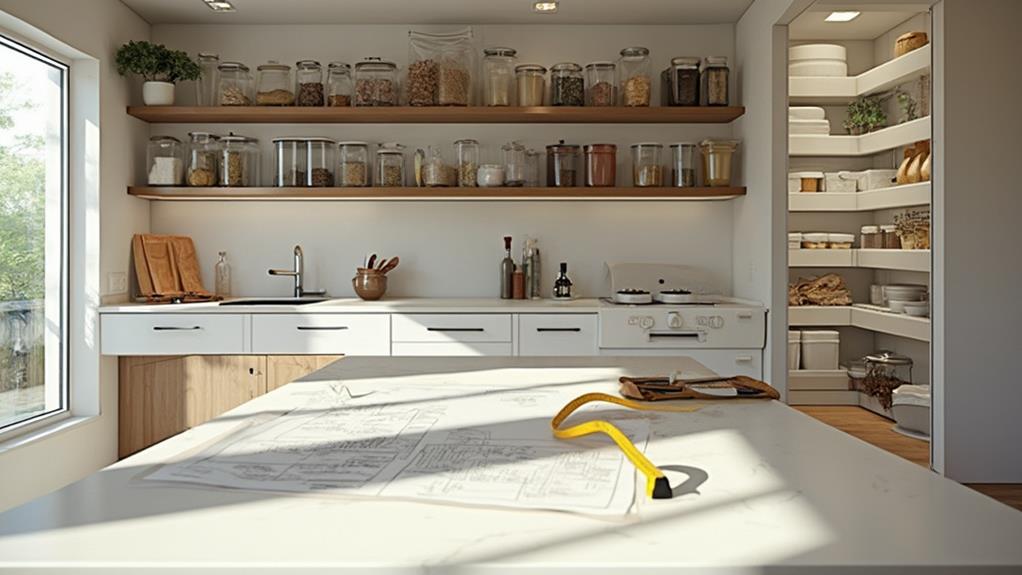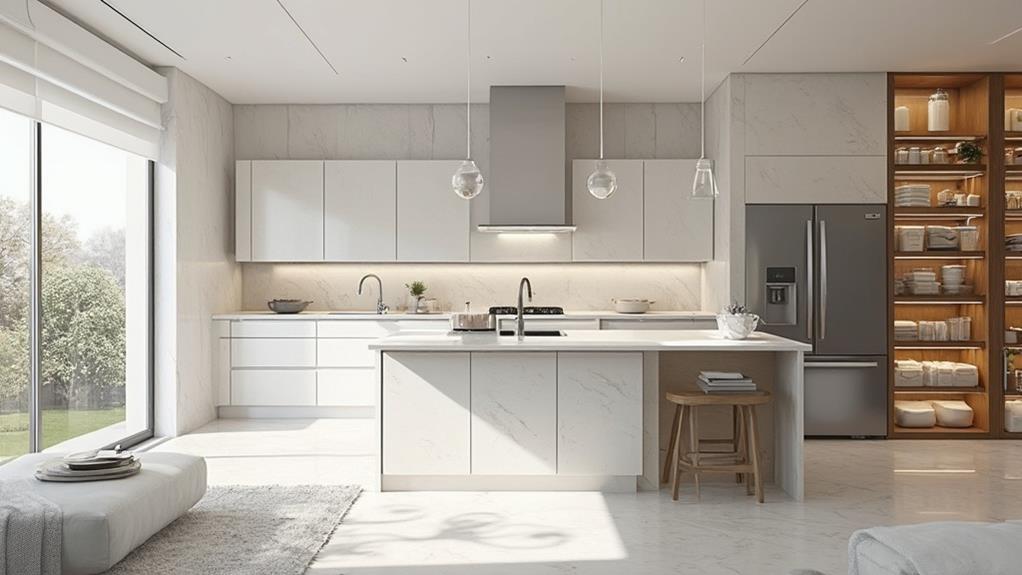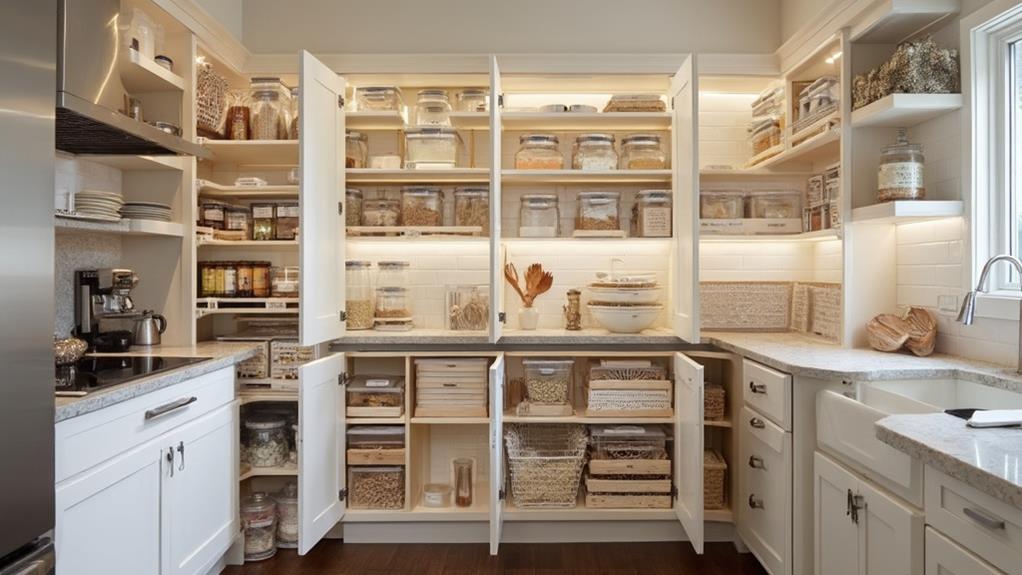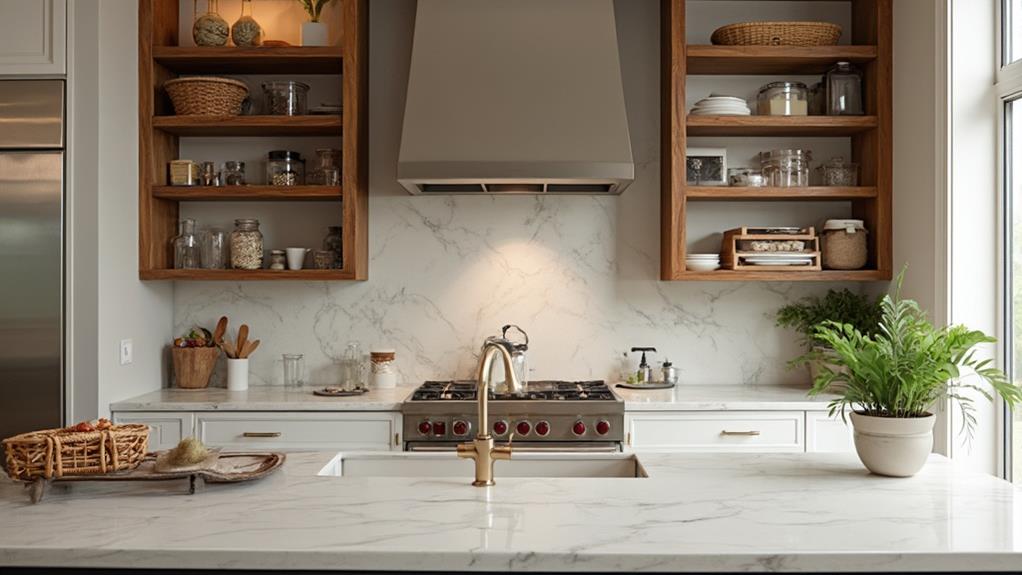When incorporating a pantry into your kitchen remodel, start by assessing your space and storage needs. Choose from various pantry types like walk-in, reach-in, or pull-out, depending on your kitchen size and lifestyle. Consider design elements such as lighting, ventilation, and adjustable shelving to maximize efficiency. Organize your pantry with clear containers, labels, and a logical system for easy access. Maximize storage by utilizing vertical space and investing in smart storage solutions. Set a realistic budget, prioritizing essential elements over decorative touches. With careful planning and thoughtful design, you'll create a pantry that enhances your kitchen's functionality and style.
Assessing Your Space

Before diving into your pantry kitchen remodel, it's crucial to thoroughly assess your space. Take measurements of your kitchen, including the walls, floors, and existing cabinetry. Identify potential areas where you could incorporate a pantry, such as unused corners, alcoves, or space adjacent to your refrigerator.
Consider your storage needs and how much space you'll require for your pantry. Make a list of items you want to store, including dry goods, canned foods, small appliances, and cookware. This will help you determine the size and type of pantry that will work best for your kitchen.
Evaluate your kitchen's layout and traffic flow. Ensure that adding a pantry won't obstruct movement or create bottlenecks. Look for opportunities to improve functionality by relocating appliances or adjusting the placement of work zones.
Don't forget to assess your budget and timeline. Determine how much you're willing to spend on your pantry remodel and how long you can afford to have your kitchen under construction. This will guide your decisions on materials, design complexity, and whether to hire professionals or tackle the project yourself.
Types of Pantries
There are four main types of pantries you can consider for your kitchen remodel: walk-in pantries, reach-in pantries, butler's pantries, and pull-out pantries.
Walk-in pantries are spacious, room-like storage areas that allow you to step inside and browse your items. They're ideal for large kitchens and families who need to store bulk items.
Reach-in pantries are smaller, closet-like spaces with shelves and often a door. They're great for medium-sized kitchens and offer easy access to everyday items.
Butler's pantries are separate rooms between the kitchen and dining area, traditionally used for food preparation and storage. They're perfect for entertainers and those who want a dedicated space for serving dishes and glassware.
Pull-out pantries are narrow, vertical storage units that slide out from cabinets. They maximize space in small kitchens and provide excellent organization for canned goods and spices.
When choosing a pantry type, consider your kitchen's size, your storage needs, and your lifestyle. Walk-in and butler's pantries require more space but offer ample storage. Reach-in and pull-out pantries are more compact solutions that can fit into various kitchen layouts.
Design Considerations

Once you've selected the type of pantry that best suits your needs, it's time to focus on design considerations. Start by assessing your storage requirements and lifestyle habits. Consider the types of items you'll store and how frequently you'll access them. This will help you determine the ideal shelf depths, spacing, and organizational features.
Lighting is crucial in a pantry. Install bright, even illumination to ensure you can easily see and access all items. Motion-activated lights can be convenient and energy-efficient. Consider the door style carefully; sliding or pocket doors can save space, while glass doors allow you to view contents at a glance.
Ventilation is important, especially if you're storing perishables. Ensure proper air circulation to prevent mustiness and maintain food quality. Incorporate adjustable shelving and pull-out drawers for flexibility and easy access. Don't forget to include dedicated spaces for small appliances, bulk items, and awkwardly shaped objects.
Choose durable, easy-to-clean materials for shelving and flooring. Consider adding a countertop for food prep or as a landing zone for groceries. Finally, integrate your pantry's design with the overall kitchen aesthetic for a cohesive look.
Organizing Your Pantry
With your pantry design in place, it's time to tackle organization. Start by categorizing your items into groups like baking supplies, canned goods, snacks, and pasta. Use clear, airtight containers for bulk items to keep them fresh and easily visible. Label everything to ensure quick identification and maintain order.
Invest in adjustable shelving to accommodate items of various heights and maximize vertical space. Install pull-out drawers or lazy Susans for hard-to-reach corners. Utilize door-mounted racks for spices, oils, and small packets. Consider adding a step stool or ladder for accessing upper shelves safely.
Group frequently used items at eye level for easy access. Store heavier items on lower shelves to prevent accidents. Use baskets or bins to corral smaller items and create a cohesive look. Implement a first-in, first-out system for perishables to minimize waste.
Create zones within your pantry for different meal types or family members. This can streamline meal planning and grocery shopping. Regularly review and declutter your pantry to maintain organization and ensure you're not holding onto expired items. With these strategies, you'll create an efficient, functional pantry that enhances your kitchen's overall usability.
Maximizing Storage Efficiency

Storage wizards know that maximizing efficiency is key to a successful pantry remodel. To make the most of your space, start by investing in adjustable shelving systems. These allow you to customize shelf heights to accommodate various item sizes, eliminating wasted vertical space. Consider pull-out drawers and lazy Susans for deep corners, making hard-to-reach items easily accessible.
Utilize the back of your pantry door with over-the-door organizers or hanging racks for spices, oils, and small packets. Group similar items together and use clear, airtight containers for bulk goods like flour, sugar, and pasta. This not only keeps food fresh but also creates a uniform look that's easy to navigate.
Don't forget about vertical space – install hooks or pegboards on empty wall areas to hang utensils, measuring cups, or even small pots and pans. For oddly shaped items or appliances you don't use often, consider adding a few deep bins or baskets on upper shelves. Label everything clearly to maintain organization and make restocking a breeze. By implementing these strategies, you'll transform your pantry into a highly efficient storage powerhouse.
Budgeting for Your Pantry
While maximizing storage efficiency is important, it's equally vital to consider the financial aspect of your pantry remodel. Start by setting a realistic budget that accounts for all aspects of the project, including materials, labor, and any unexpected costs. Research prices for shelving units, storage containers, and organizational systems to get a clear picture of potential expenses.
Consider prioritizing your needs and wants. Focus on essential elements first, such as durable shelving and functional storage solutions. You can always add decorative touches or high-end finishes later if your budget allows. Don't forget to factor in the cost of any necessary electrical work or lighting upgrades.
Look for ways to save money without compromising quality. Compare prices from different suppliers, consider DIY options for simpler tasks, and keep an eye out for sales or discounts on pantry essentials. If you're working with a contractor, get multiple quotes and be clear about your budget constraints.
Remember to set aside a contingency fund of about 10-15% of your total budget for unforeseen expenses. This will help you avoid financial stress if unexpected issues arise during the remodel.
Conclusion
You've now got all the ingredients to create a pantry that'll make your kitchen the envy of every chef on the planet. Whether you're going for a walk-in wonderland or a cleverly concealed cabinet, your new pantry will revolutionize your cooking space. Remember to plan carefully, organize thoughtfully, and maximize every inch. With these tips, you'll transform your kitchen into a storage superstar that'll keep your culinary creativity flowing for years to come.

